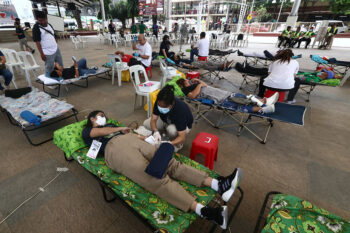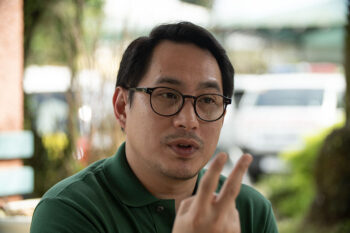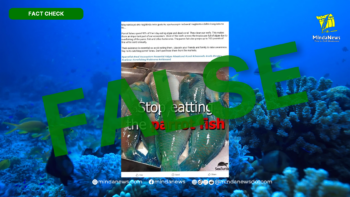[My paper written in typewriter when I was a participant at the Eleventh Annual Seminar Session on Mindanao and Sulu Cultures, Dr. Peter Gowing Memorial Research Center, Marawi City April 15 to May 10, 1985; delivered at the First Assembly of Ranao Development Forum, 18-19 May 1985, Marawi City. Slightly revised.]
The Bangsamoro People’s Fight for Self-Determination: Historical Perspective
ILIGAN CITY (MindaNews / 24 October) —To be able to situate the Bangsamoro people’s struggle in its correct historical perspective, we have to step back into history and find out why in the first place the Moro people are engaged in their present aspiration. Officially, the Moro people are classified as cultural minorities. And they have not delighted in both the label and the accompanying socio-economic situation. They feel exploited and oppressed. How do they view their own situation?
We are told that before the arrival of the Spanish colonizers, the Moro people were the most dominant groups all over the archipelago. Economically, they dominated both inter-island trade and trade with the outside. Politically, they alone had a centralized form of government albeit feudal. The Sulu sultanate had existed since 1450; the Maguindanao sultanate, formerly divided into Maguindanao and Buayan principalities, came into form around the second decade of the 17th century. Communities in the rest of the archipelago were still in either communal or have barely emerged from the communal system, such as the barangays. Religiously, the Moro people alone had a monotheistic belief system in Islam, while the rest were still in the state of diwata and anito. This situation was changed radically with the arrival of the Spaniards.
During the period of Spanish colonization, the peoples in the Philippines may be categorized into two: the conquered and the unconquered. The conquered were those who became Christians; the unconquered were those who fought the Spaniards, lost a lot of battles, won some but remained free (Igorot and Bangsamoro), and those who avoided confrontation with the Spaniards, and by so doing also remained free. Though uncolonized the unconquered later became the cultural minorities. This calls for an explanation.
In their own struggle to regain their lost freedom, those colonized at first fought in isolated from one another, usually according to their ethnic lines, as exemplified in the more than 200 revolts. But starting from the propaganda period, roughly 1885, the Filipino nation began to take shape such that when the 1896 revolution took the arena, there was now a people bannering the Filipino nation fighting for national independence. The Moros were not yet part of this nation then. Nor were most of those who evaded colonization.
It was in the three hundred thirty-three years of Spanish domination that much of the Moro dominance was eroded. Economically, they were no longer free to roam the seas of the Visayas and Luzon as they were wont to in the past – as traders. The presence of Dutch colonizers in Indonesia effectively restricted their trading activities with that part of Asia from the 18th century. The English colonizers in what is now Malaysia imposed their own limitation to Moro trade activities. The Galleon trade of the Spaniards siphoned off what trade there was with China. Subjected to more than three hundred years of warfare, even production on home grounds deteriorated tremendously. And so it was within this broad context that we should try to comprehend Moro depredation in Luzon and the Visayas. Not only were the Moros retaliating from Spanish attacks, they also saw in these counter-expeditions opportunities to replenish heavily depleted economic resources. Since in most instances, they attacked during the harvest season, they therefore made it a point to bring back with them the harvests as well as the harvesters, among others. Christian captives, sometimes numbering in hundreds were eventually sold and employed in spice plantations, mostly likely in what is part of Indonesia.
A unique feature of the Moro-Spanish war was the divide and rule tactics of the Spanish colonizers. Large numbers of Christian Filipino conscripts, labelled as Indios, were employed in all Spanish expeditions to Moroland. And in the Moro counter-attacks, it was also the Christian Filipinos who bore the brunt of defending Spanish-controlled settlements. No wonder that at the end of the long war, Moros and Christian Filipinos hated each other.
In the end, while the Moros were essentially unvanguished and they took great pride in this, they were also severely weakened and poor. Gone was their status of dominance before the arrival of the colonizers. Even their own sultanate territorial domains were tremendous eroded. At their peak, the two Moro sultanates encompassed all of Sulu, Palawan, Borneo and Mindanao. At the end of the Spanish colonial era, Palawan and Samboangan (roughly the present Zamboanga City) had slipped from the hands of the Sulu Sultanate. The Maguindanao sultanate, for its part, had lost Davao, Surigao, Agusan, Misamis (which included both the present Oriental and Occidental and Iligan), portions of Bukidnon, parts of Zamboanga del Sur and Zamboanga del Norte.
And so, in the Moro people’s fight for self-determination during the Spanish period, they emerged victorious in the sense that they succeeded in preserving their freedom but were also severely battered. The final blow was to be delivered by the American imperialists.
With the use of armed might, the American imperialists conquered everyone in the entirety in what is now the Philippine archipelago. And in the census of 1903, they classified the people into two: the civilized and the uncivilized. The Christian Filipinos were the civilized, and the uncivilized were the Moros and the so-called non-Christian wild tribes. And this classification, used as a basis for such arrangements as the Moro Province (1903-1913), has stuck to this day. In 1957, both Moros and tribal Filipinos were formally and officially labelled with the creation off the Commission of National Integration as Cultural Minorities. By American imperialist decree, these people were to be assimilated into the mainstream of Philippine body politic. Or to be integrated into the Filipino nation.
In April 1903, barely two months before the creation of the Moro Province, the American colonial government passed a law declaring null and void all land grants made by both Muslim and non-Muslim datus without the consent of the government. Both Moro and tribal ancestral lands, if unoccupied, were now classified as public lands. Also, Moro and tribal customary laws were declared as absurd and unfit to serve as a basis for a civilized system of government. There was nothing left now except to submit to the dictates of the American colonial government.
The entry of American and Japanese investors- settlers starting in 1913 and the large-scale migration under government auspices of Christian Filipino settlers into Mindanao brought about a radical change in the lives of both Moros and tribal peoples. Their claim to ancestral land, their tradition of land distribution, these were no longer theirs to decide on.
With the introduction of the public school system which was to become a most effective tool of conquest, the minds of the young natives of Mindanao were shaped in the American mould.
Thus did the American colonizers delivered the death blow to Moro self-determination. The Commonwealth and the Republic of the Philippines later adopted the basic policies imposed by the Americans.
Historically, therefore, we can see that the Moro struggle for self-determination, sustained successfully during the Spanish period, took a turn for the worse during the American period. The uncritical adoption by the Commonwealth and the Philippine Republic of basically the same policies towards both Moros and tribal Filipinos merely prolonged the latters’ state of oppression and exploitation. And this is because up to now, the entire Philippines is within the effective clutches of American neo-colonialism. But how does the MNLF view their present situation? (MindaViews is the opinion section of MindaNews. A peace specialist, Rudy Buhay Rodil is an active Mindanao historian and peace advocate)







